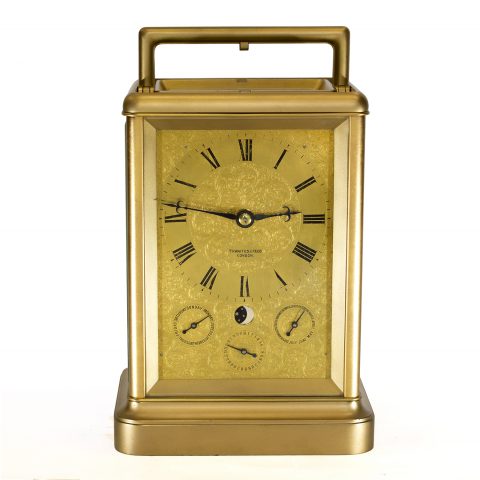English fusee Giant Carriage Clock with Perpetual Calendar

A very rare find, this fine giant carriage clock by Thwaites & Reed, London is from one of the biggest names in English clock-making history, beautifully engineered in all respects.
The 8-day striking fusee movement has its original gilded massive lever platform escapement with a cut bimetallic balance with its large oversized timing screws. It is fully jewelled throughout with removal screwed end-plates. The time side additionally benefits from maintaining power.
The strike side rings on a large blued steel coiled gong wit the hammer filled with a leather section to give it a particularly mellow tone.
And now onto the interesting technical bit. As you can see from the dial this clock displays days, date, month and moon phase. Consequently, as the photos show the gearing and levers required to action this are complex and precise. The perpetual calendar movement corrects for the different lengths of the months. These can be adjusted and set from knobs protruding from the rear of the movement.
The beautiful dial has a 6-inch gilt chapter ring, the gilt ground very well engraved with floral decoration.
The original blued steel hands are all matching.
The very large case has a handle made in two pieces which fold flush to the case when not in use. Although very large, the case has an elegant appeal given the soft corners. It has been regilded in a soft satin finish at some stage in its past, and is still presented in excellent condition.
The movement is stamped with serial number 14911 and T&R. The stamps are rather hidden on the front-plate, obscured by the numerous wheels and levers positioned on the front-plate. This serial number dates the clock to 1885, according to the records of Thwaites and Reed reproduced in the book English Dial Clocks by Ronald Rose.
The identical (this?) clock is illustrated and described in Carriage Clocks, Their History and Development by Charles Allix and Peter Bonnert [pages 275-277, Plate IX/58.] On the illustrated example (most probably this very clock), the serial number was not found. Most likely the reason for this is that the clock was borrowed from Aspreys for the purposes of book photography and the clock could not be stripped down to look for this level of detail. A date of 1850 was deduced on the basis of comparison with a very similar case on Dent’s chronometer carriage clock no. 14880.
- Height: 13 inches (33cms) handles down; 15 inches (38cms) handles up
- Width: 23 cms
- Depth: 18 cms
The movement is to be overhauled and guaranteed for 3 years.
History of Thwaites and Reed:
Aynsworth Thwaites founded the company in Rosoman Street, Clerkenwell, London in 1740, which moved to Bowling Green Lane in 1780 when John Thwaites took over. The company’s earliest recorded commission was a turret clock for Horseguards Parade made between 1740 and 1768, still in use today. In 1816 John Thwaites partnered with George Jeremiah Reed and the business Thwaites & Reed was formed. John Thwaite remained at the firm’s head until 1842. In 1856 Thomas Buggins purchased the business from Henrietta Reed, the widow of George Jeremiah Reed, and the business remained in the Buggins family for four generations. It continues under other ownership today, and claims to be the oldest English clock manufacturer.